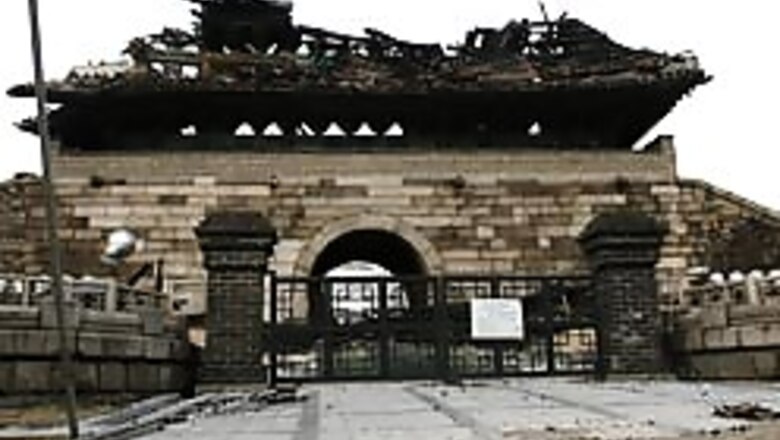
views
Seoul: South Korean police said on Tuesday they arrested a pensioner who confessed to burning down a 600-year-old gate designated as the country's number one national treasure because he was angry about a compensation payment.
The stone and wood structure Namdaemun, or "Great South Gate," was reduced to a charred hulk on Monday, with newspaper editorials lamenting the destruction of an iconic symbol of national pride.
Labourer Heo Eun stood at Namdaemun and summing up the sense of loss and shock shared by many South Koreans said: "It feels like the heart of the nation was destroyed overnight". The 69-year-old suspect is a convicted arsonist identified only by his family name Chae, said Namdaemun police station chief Kim Young-soo. Chae was taken into custody late on Monday and told police he had planned the fire for several months.
"(He said) he committed the crime out of anger because he felt the government did not take enough care with the appeal he filed after being insufficiently compensated for redevelopment in his residential area," Kim told a news conference.
Chae, who was given a suspended sentence after setting fire that singed a small part of a palace in Seoul in 2006, said he used a ladder to climb into the gate's pavilion.
He then poured paint thinner on the floor and set it ablaze, police said. "I would like to say sorry to all South Koreans. I cannot apologise enough to my children and the people of this country," Chae told a group of reporters at a police station.
Newspaper editorials on Tuesday said the loss of Namdaemun was an embarrassment that could have easily been prevented through better security and fire fighting measures.
The gate was the oldest wooden structure in Seoul. It had withstood invasions, colonial occupation and was one of the few historic structures in the capital to remain standing after the 1950-1953 Korean War. "It was ruined in six hours due to our lack of care and attention," the mainstream JoongAng Ilbo newspaper said.
Experts said misjudgement by nearly everyone involved led to the devastation. The head of the Cultural Heritage Administration, whose agency faced stiff criticism for its management of the national treasure, offered to resign on Tuesday, a government official said.
Many of the thousands who viewed the ruins pointed fingers angrily at politicians, bureaucrats, firefighters and police for failing to protect the landmark.
Some blamed the outgoing government of President Roh Moo-hyun, which had a separate national treasure burn down in a forest fire during its watch, for not learning from that loss. Others castigated President-elect Lee Myung-bak, who as mayor of Seoul allowed the gate to be opened to the public and promoted it as a tourist destination.
Chae told police he selected Namdaemun because of its easy access. The gate, used as the centrepiece of the country's international tourism campaign, was constructed in 1398 and served as the main southern entrance for Seoul when it became Korea's capital more than 600 years ago and was a walled city.
Ancient kings built gates at specific locations in the belief they would strike a balance with nature that could bring them fortune or block evil spirits. Namdaemun was one of the great gates and built to block the energy of fire and protect the main Gyeongbokgung palace a short distance to the north.
The structure, also called Sungnyemun or "Gate of Exalted Ceremonies", has been restored several times. The last major renovation took place in the early 1960s.
An official with the Cultural Heritage Administration said it would spend three years and 20 billion won ($21.2 million) to rebuild the structure.















Comments
0 comment